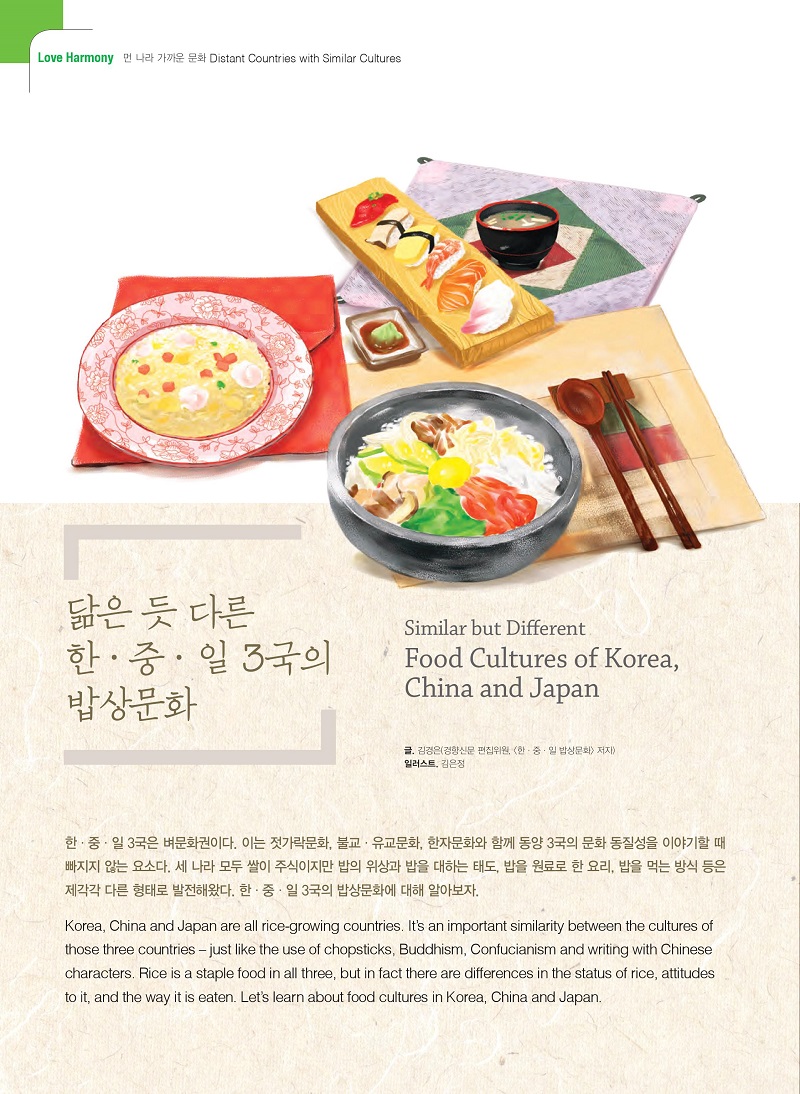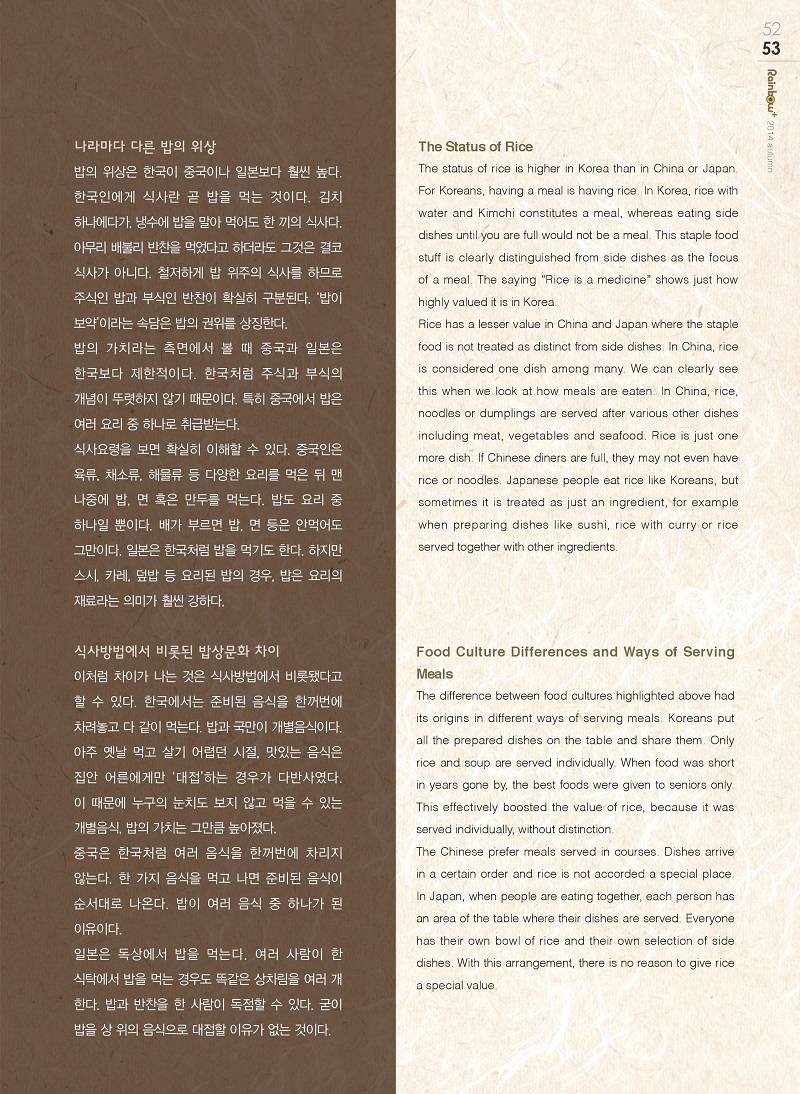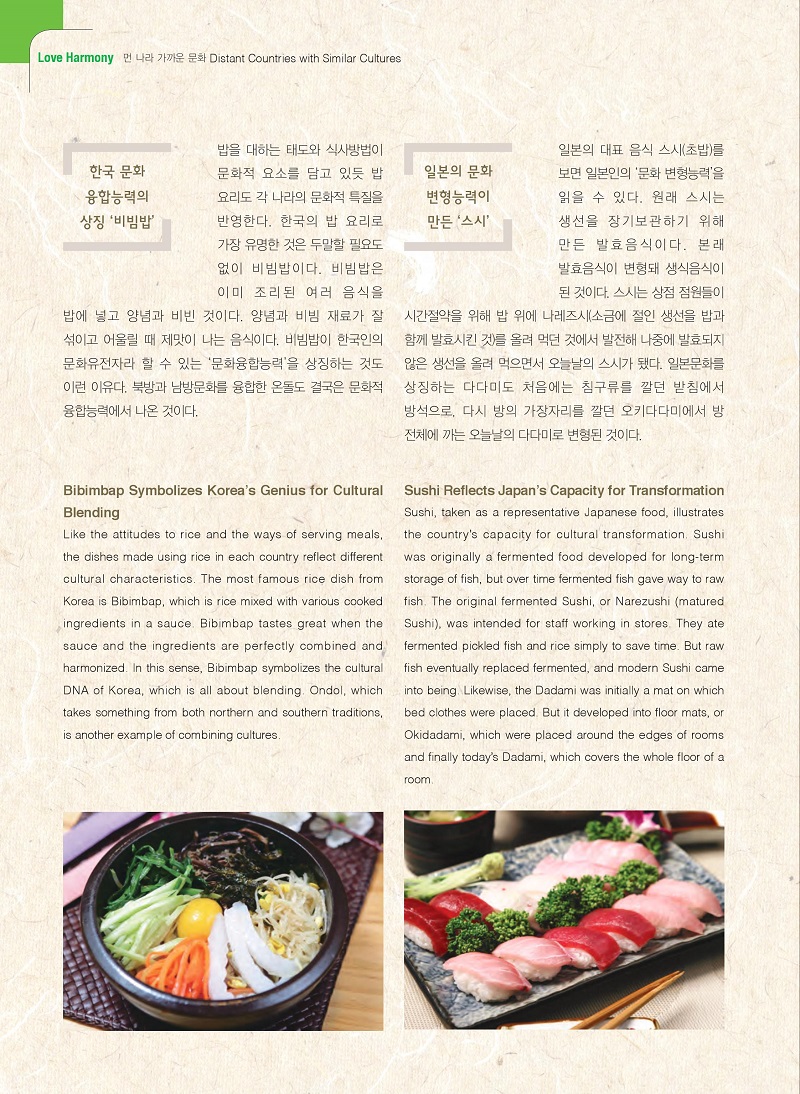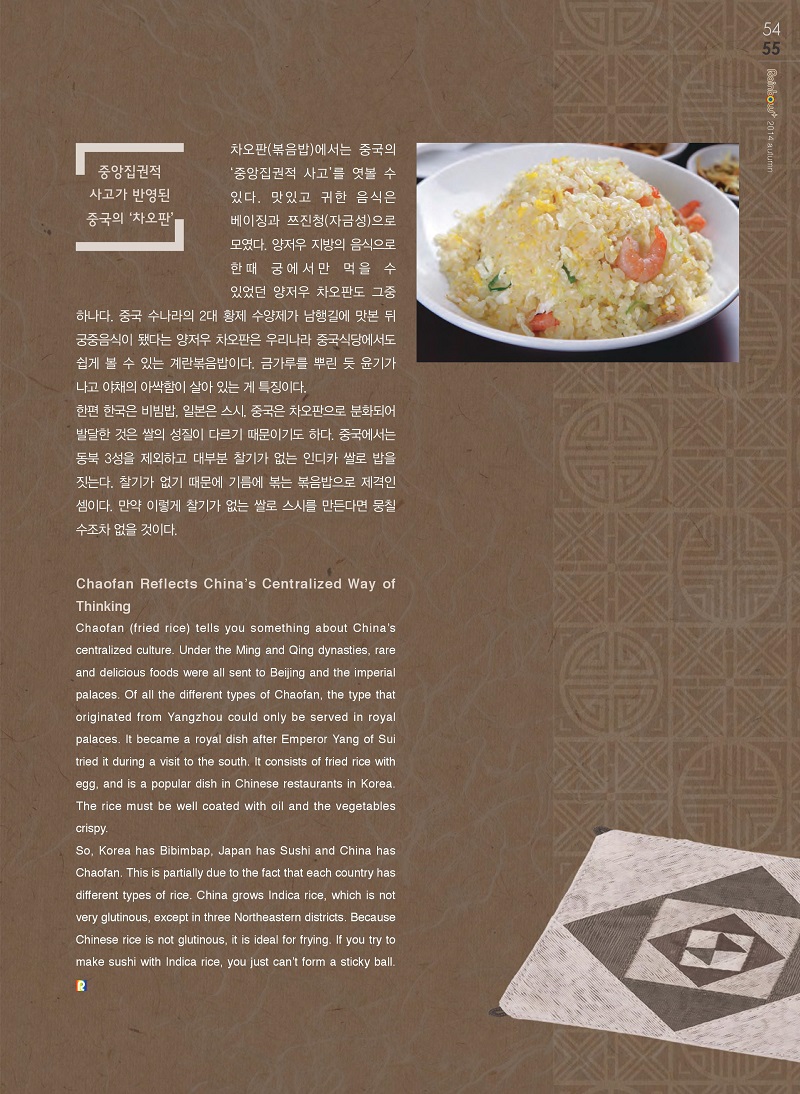화면이 정상적으로 보이지 않을 경우, Ctrl + Shift + R(캐시 비우기 및 강력 새로고침)으로 캐시를 새로고침해 주세요.
전체메뉴
- 구글번역
-
구글번역 닫기
좌측메뉴
한국정착정보
서브 콘텐츠 시작
현재 페이지 위치
- 한국정착정보
- 정보자료실
- 그래픽자료실
그래픽자료실
- 닮은 듯 다른 한·중·일 3국의 밥상 문화
- 2018-12-28 조회수 71
-
 닮은 듯 다른한·중·일 3국의밥상문화 Similar but Different Food Cultures of Korea, China and Japan 한·중·일 3국은 벼문화권이다. 이는 젓가락문화, 불교·유교문화, 한자문화와 함께 동양 3국의 문화 동질성을 이야기할 때 빠지지 않는 요소다. 세 나라 모두 쌀이 주식이지만 밥의 위상과 밥을 대하는 태도, 밥을 원료로 한 요리, 밥을 먹는 방식 등은 제각각 다른 형태로 발전해왔다. 한·중·일 3국의 밥상문화에 대해 알아보자. Korea, China and Japan are all rice-growing countries. It’s an important similarity between the cultures of those three countries just like the use of chopsticks, Buddhism, Confucianism and writing with Chinese characters. Rice is a staple food in all three, but in fact there are differences in the status of rice, attitudes to it, and the way it is eaten. Let’s learn about food cultures in Korea, China and Japan.
닮은 듯 다른한·중·일 3국의밥상문화 Similar but Different Food Cultures of Korea, China and Japan 한·중·일 3국은 벼문화권이다. 이는 젓가락문화, 불교·유교문화, 한자문화와 함께 동양 3국의 문화 동질성을 이야기할 때 빠지지 않는 요소다. 세 나라 모두 쌀이 주식이지만 밥의 위상과 밥을 대하는 태도, 밥을 원료로 한 요리, 밥을 먹는 방식 등은 제각각 다른 형태로 발전해왔다. 한·중·일 3국의 밥상문화에 대해 알아보자. Korea, China and Japan are all rice-growing countries. It’s an important similarity between the cultures of those three countries just like the use of chopsticks, Buddhism, Confucianism and writing with Chinese characters. Rice is a staple food in all three, but in fact there are differences in the status of rice, attitudes to it, and the way it is eaten. Let’s learn about food cultures in Korea, China and Japan. 나라마다 다른 밥의 위상 밥의 위상은 한국이 중국이나 일본보다 훨씬 높다. 한국인에게 식사란 곧 밥을 먹는 것이다. 김치 하나에다가, 냉수에 밥을 말아 먹어도 한 끼의 식사다. 아무리 배불리 반찬을 먹었다고 하더라도 그것은 결코 식사가 아니다. 철저하게 밥 위주의 식사를 하므로 주식인 밥과 부식인 반찬이 확실히 구분된다. ‘밥이 보약’이라는 속담은 밥의 권위를 상징한다. 밥의 가치라는 측면에서 볼 때 중국과 일본은 한국보다 제한적이다. 한국처럼 주식과 부식의 개념이 뚜렷하지 않기 때문이다. 특히 중국에서 밥은 여러 요리 중 하나로 취급받는다. 식사요령을 보면 확실히 이해할 수 있다. 중국인은 육류, 채소류, 해물류 등 다양한 요리를 먹은 뒤 맨 나중에 밥, 면 혹은 만두를 먹는다. 밥도 요리 중 하나일 뿐이다. 배가 부르면 밥, 면 등은 안먹어도 그만이다. 일본은 한국처럼 밥을 먹기도 한다. 하지만 스시, 카레, 덮밥 등 요리된 밥의 경우, 밥은 요리의 재료라는 의미가 훨씬 강하다. 식사방법에서 비롯된 밥상문화 차이 이처럼 차이가 나는 것은 식사방법에서 비롯됐다고 할 수 있다. 한국에서는 준비된 음식을 한꺼번에 차려놓고 다 같이 먹는다. 밥과 국만이 개별음식이다. 아주 옛날 먹고 살기 어렵던 시절, 맛있는 음식은 집안 어른에게만 ‘대접’하는 경우가 다반사였다. 이 때문에 누구의 눈치도 보지 않고 먹을 수 있는 개별음식, 밥의 가치는 그만큼 높아졌다. 중국은 한국처럼 여러 음식을 한꺼번에 차리지 않는다. 한 가지 음식을 먹고 나면 준비된 음식이 순서대로 나온다. 밥이 여러 음식 중 하나가 된 이유이다. 일본은 독상에서 밥을 먹는다. 여러 사람이 한 식탁에서 밥을 먹는 경우도 똑같은 상차림을 여러 개 한다. 밥과 반찬을 한 사람이 독점할 수 있다. 굳이 밥을 상 위의 음식으로 대접할 이유가 없는 것이다. The Status of Rice The status of rice is higher in Korea than in China or Japan. For Koreans, having a meal is having rice. In Korea, rice with water and Kimchi constitutes a meal, whereas eating side dishes until you are full would not be a meal. This staple food stuff is clearly distinguished from side dishes as the focus of a meal. The saying “Rice is a medicine” shows just how highly valued it is in Korea. Rice has a lesser value in China and Japan where the staple food is not treated as distinct from side dishes. In China, rice is considered one dish among many. We can clearly see this when we look at how meals are eaten. In China, rice, noodles or dumplings are served after various other dishes including meat, vegetables and seafood. Rice is just one more dish. If Chinese diners are full, they may not even have rice or noodles. Japanese people eat rice like Koreans, but sometimes it is treated as just an ingredient, for example when preparing dishes like sushi, rice with curry or rice served together with other ingredients. Food Culture Differences and Ways of Serving Meals The difference between food cultures highlighted above had its origins in different ways of serving meals. Koreans put all the prepared dishes on the table and share them. Only rice and soup are served individually. When food was short in years gone by, the best foods were given to seniors only. This effectively boosted the value of rice, because it was served individually, without distinction. The Chinese prefer meals served in courses. Dishes arrive in a certain order and rice is not accorded a special place. In Japan, when people are eating together, each person has an area of the table where their dishes are served. Everyone has their own bowl of rice and their own selection of side dishes. With this arrangement, there is no reason to give rice a special value.
나라마다 다른 밥의 위상 밥의 위상은 한국이 중국이나 일본보다 훨씬 높다. 한국인에게 식사란 곧 밥을 먹는 것이다. 김치 하나에다가, 냉수에 밥을 말아 먹어도 한 끼의 식사다. 아무리 배불리 반찬을 먹었다고 하더라도 그것은 결코 식사가 아니다. 철저하게 밥 위주의 식사를 하므로 주식인 밥과 부식인 반찬이 확실히 구분된다. ‘밥이 보약’이라는 속담은 밥의 권위를 상징한다. 밥의 가치라는 측면에서 볼 때 중국과 일본은 한국보다 제한적이다. 한국처럼 주식과 부식의 개념이 뚜렷하지 않기 때문이다. 특히 중국에서 밥은 여러 요리 중 하나로 취급받는다. 식사요령을 보면 확실히 이해할 수 있다. 중국인은 육류, 채소류, 해물류 등 다양한 요리를 먹은 뒤 맨 나중에 밥, 면 혹은 만두를 먹는다. 밥도 요리 중 하나일 뿐이다. 배가 부르면 밥, 면 등은 안먹어도 그만이다. 일본은 한국처럼 밥을 먹기도 한다. 하지만 스시, 카레, 덮밥 등 요리된 밥의 경우, 밥은 요리의 재료라는 의미가 훨씬 강하다. 식사방법에서 비롯된 밥상문화 차이 이처럼 차이가 나는 것은 식사방법에서 비롯됐다고 할 수 있다. 한국에서는 준비된 음식을 한꺼번에 차려놓고 다 같이 먹는다. 밥과 국만이 개별음식이다. 아주 옛날 먹고 살기 어렵던 시절, 맛있는 음식은 집안 어른에게만 ‘대접’하는 경우가 다반사였다. 이 때문에 누구의 눈치도 보지 않고 먹을 수 있는 개별음식, 밥의 가치는 그만큼 높아졌다. 중국은 한국처럼 여러 음식을 한꺼번에 차리지 않는다. 한 가지 음식을 먹고 나면 준비된 음식이 순서대로 나온다. 밥이 여러 음식 중 하나가 된 이유이다. 일본은 독상에서 밥을 먹는다. 여러 사람이 한 식탁에서 밥을 먹는 경우도 똑같은 상차림을 여러 개 한다. 밥과 반찬을 한 사람이 독점할 수 있다. 굳이 밥을 상 위의 음식으로 대접할 이유가 없는 것이다. The Status of Rice The status of rice is higher in Korea than in China or Japan. For Koreans, having a meal is having rice. In Korea, rice with water and Kimchi constitutes a meal, whereas eating side dishes until you are full would not be a meal. This staple food stuff is clearly distinguished from side dishes as the focus of a meal. The saying “Rice is a medicine” shows just how highly valued it is in Korea. Rice has a lesser value in China and Japan where the staple food is not treated as distinct from side dishes. In China, rice is considered one dish among many. We can clearly see this when we look at how meals are eaten. In China, rice, noodles or dumplings are served after various other dishes including meat, vegetables and seafood. Rice is just one more dish. If Chinese diners are full, they may not even have rice or noodles. Japanese people eat rice like Koreans, but sometimes it is treated as just an ingredient, for example when preparing dishes like sushi, rice with curry or rice served together with other ingredients. Food Culture Differences and Ways of Serving Meals The difference between food cultures highlighted above had its origins in different ways of serving meals. Koreans put all the prepared dishes on the table and share them. Only rice and soup are served individually. When food was short in years gone by, the best foods were given to seniors only. This effectively boosted the value of rice, because it was served individually, without distinction. The Chinese prefer meals served in courses. Dishes arrive in a certain order and rice is not accorded a special place. In Japan, when people are eating together, each person has an area of the table where their dishes are served. Everyone has their own bowl of rice and their own selection of side dishes. With this arrangement, there is no reason to give rice a special value. 한국 문화융합능력의상징 ‘비빔밥’ 밥을 대하는 태도와 식사방법이 문화적 요소를 담고 있듯 밥 요리도 각 나라의 문화적 특질을 반영한다. 한국의 밥 요리로 가장 유명한 것은 두말할 필요도 없이 비빔밥이다 . 비빔밥은 이미 조리된 여러음식 을 밥에 넣고 양념과 비빈 것이다. 양념과 비빔 재료가 잘 섞이고 어울릴 때 제맛이 나는 음식이다. 비빔밥이 한국인의 문화유전자라 할 수 있는 ‘문화융합능력’을 상징하는 것도 이런 이유다. 북방과 남방문화를 융합한 온돌도 결국은 문화적 융합능력에서 나온 것이다. Bibimbap Symbolizes Korea’s Genius for Cultural Blending Like the attitudes to rice and the ways of serving meals, the dishes made using rice in each country reflect different cultural characteristics. The most famous rice dish from Korea is Bibimbap, which is rice mixed with various cooked ingredients in a sauce. Bibimbap tastes great when the sauce and the ingredients are perfectly combined and harmonized. In this sense, Bibimbap symbolizes the cultural DNA of Korea, which is all about blending. Ondol, which takes something from both northern and southern traditions, is another example of combining cultures 일본의 문화변형능력이 만든 ‘스시’ 일본의 대표 음식 스시(초밥)를 보면 일본인의 ‘문화 변형능력’을 읽을 수 있다 . 원래 스시는 생선을 장기 보관 하기 위해 만든발효 음식이다 . 본래 발효음식이 변형돼 생식음식이 된 것이다. 스시는 상점 점원들이 시간절약을 위해 밥 위에 나레즈시(소금에 절인 생선을 밥과 함께 발효시킨 것)를 올려 먹던 것에서 발전해 나중에 발효되지 않은 생선을 올려 먹으면서 오늘날의 스시가 됐다. 일본문화를 상징하는 다다미도 처음에는 침구류를 깔던 받침에서 방석으로, 다시 방의 가장자리를 깔던 오키다다미에서 방 전체에 까는 오늘날의 다다미로 변형된 것이다. Sushi Reflects Japan’s Capacity for Transformation Sushi, taken as a representative Japanese food, illustrates the country’s capacity for cultural transformation. Sushi was originally a fermented food developed for long-term storage of fish, but over time fermented fish gave way to raw fish. The original fermented Sushi, or Narezushi (matured Sushi), was intended for staff working in stores. They ate fermented pickled fish and rice simply to save time. But raw fish eventually replaced fermented, and modern Sushi came into being. Likewise, the Dadami was initially a mat on which bed clothes were placed. But it developed into floor mats, or Okidadami, which were placed around the edges of rooms and finally today’s Dadami, which covers the whole floor of a room.
한국 문화융합능력의상징 ‘비빔밥’ 밥을 대하는 태도와 식사방법이 문화적 요소를 담고 있듯 밥 요리도 각 나라의 문화적 특질을 반영한다. 한국의 밥 요리로 가장 유명한 것은 두말할 필요도 없이 비빔밥이다 . 비빔밥은 이미 조리된 여러음식 을 밥에 넣고 양념과 비빈 것이다. 양념과 비빔 재료가 잘 섞이고 어울릴 때 제맛이 나는 음식이다. 비빔밥이 한국인의 문화유전자라 할 수 있는 ‘문화융합능력’을 상징하는 것도 이런 이유다. 북방과 남방문화를 융합한 온돌도 결국은 문화적 융합능력에서 나온 것이다. Bibimbap Symbolizes Korea’s Genius for Cultural Blending Like the attitudes to rice and the ways of serving meals, the dishes made using rice in each country reflect different cultural characteristics. The most famous rice dish from Korea is Bibimbap, which is rice mixed with various cooked ingredients in a sauce. Bibimbap tastes great when the sauce and the ingredients are perfectly combined and harmonized. In this sense, Bibimbap symbolizes the cultural DNA of Korea, which is all about blending. Ondol, which takes something from both northern and southern traditions, is another example of combining cultures 일본의 문화변형능력이 만든 ‘스시’ 일본의 대표 음식 스시(초밥)를 보면 일본인의 ‘문화 변형능력’을 읽을 수 있다 . 원래 스시는 생선을 장기 보관 하기 위해 만든발효 음식이다 . 본래 발효음식이 변형돼 생식음식이 된 것이다. 스시는 상점 점원들이 시간절약을 위해 밥 위에 나레즈시(소금에 절인 생선을 밥과 함께 발효시킨 것)를 올려 먹던 것에서 발전해 나중에 발효되지 않은 생선을 올려 먹으면서 오늘날의 스시가 됐다. 일본문화를 상징하는 다다미도 처음에는 침구류를 깔던 받침에서 방석으로, 다시 방의 가장자리를 깔던 오키다다미에서 방 전체에 까는 오늘날의 다다미로 변형된 것이다. Sushi Reflects Japan’s Capacity for Transformation Sushi, taken as a representative Japanese food, illustrates the country’s capacity for cultural transformation. Sushi was originally a fermented food developed for long-term storage of fish, but over time fermented fish gave way to raw fish. The original fermented Sushi, or Narezushi (matured Sushi), was intended for staff working in stores. They ate fermented pickled fish and rice simply to save time. But raw fish eventually replaced fermented, and modern Sushi came into being. Likewise, the Dadami was initially a mat on which bed clothes were placed. But it developed into floor mats, or Okidadami, which were placed around the edges of rooms and finally today’s Dadami, which covers the whole floor of a room. 중앙집권적사고가 반영된중국의 ‘차오판’ 차오판(볶음밥)에서는 중국의 ‘중앙집권적 사고’를 엿볼 수 있 다 . 맛 있 고 귀 한 음 식 은 베이징과 쯔진청(자금성)으로 모였다. 양저우 지방의 음식으로 한 때 궁 에 서 만 먹 을 수 있었던 양저우 차오판도 그중 하나다. 중국 수나라의 2대 황제 수양제가 남행길에 맛본 뒤 궁중음식이 됐다는 양저우 차오판은 우리나라 중국식당에서도 쉽게 볼 수 있는 계란볶음밥이다. 금가루를 뿌린 듯 윤기가 나고 야채의 아싹함이 살아 있는 게 특징이다. 한편 한국은 비빔밥, 일본은 스시, 중국은 차오판으로 분화되어 발달한 것은 쌀의 성질이 다르기 때문이기도 하다. 중국에서는 동북 3성을 제외하고 대부분 찰기가 없는 인디카 쌀로 밥을 짓는다. 찰기가 없기 때문에 기름에 볶는 볶음밥으로 제격인 셈이다. 만약 이렇게 찰기가 없는 쌀로 스시를 만든다면 뭉칠 수조차 없을 것이다. Chaofan Reflects China’s Centralized Way of Thinking Chaofan (fried rice) tells you something about China’s centralized culture. Under the Ming and Qing dynasties, rare and delicious foods were all sent to Beijing and the imperial palaces. Of all the different types of Chaofan, the type that originated from Yangzhou could only be served in royal palaces. It became a royal dish after Emperor Yang of Sui tried it during a visit to the south. It consists of fried rice with egg, and is a popular dish in Chinese restaurants in Korea. The rice must be well coated with oil and the vegetables crispy. So, Korea has Bibimbap, Japan has Sushi and China has Chaofan. This is partially due to the fact that each country has different types of rice. China grows Indica rice, which is not very glutinous, except in three Northeastern districts. Because Chinese rice is not glutinous, it is ideal for frying. If you try to make sushi with Indica rice, you just can’t form a sticky ball.
중앙집권적사고가 반영된중국의 ‘차오판’ 차오판(볶음밥)에서는 중국의 ‘중앙집권적 사고’를 엿볼 수 있 다 . 맛 있 고 귀 한 음 식 은 베이징과 쯔진청(자금성)으로 모였다. 양저우 지방의 음식으로 한 때 궁 에 서 만 먹 을 수 있었던 양저우 차오판도 그중 하나다. 중국 수나라의 2대 황제 수양제가 남행길에 맛본 뒤 궁중음식이 됐다는 양저우 차오판은 우리나라 중국식당에서도 쉽게 볼 수 있는 계란볶음밥이다. 금가루를 뿌린 듯 윤기가 나고 야채의 아싹함이 살아 있는 게 특징이다. 한편 한국은 비빔밥, 일본은 스시, 중국은 차오판으로 분화되어 발달한 것은 쌀의 성질이 다르기 때문이기도 하다. 중국에서는 동북 3성을 제외하고 대부분 찰기가 없는 인디카 쌀로 밥을 짓는다. 찰기가 없기 때문에 기름에 볶는 볶음밥으로 제격인 셈이다. 만약 이렇게 찰기가 없는 쌀로 스시를 만든다면 뭉칠 수조차 없을 것이다. Chaofan Reflects China’s Centralized Way of Thinking Chaofan (fried rice) tells you something about China’s centralized culture. Under the Ming and Qing dynasties, rare and delicious foods were all sent to Beijing and the imperial palaces. Of all the different types of Chaofan, the type that originated from Yangzhou could only be served in royal palaces. It became a royal dish after Emperor Yang of Sui tried it during a visit to the south. It consists of fried rice with egg, and is a popular dish in Chinese restaurants in Korea. The rice must be well coated with oil and the vegetables crispy. So, Korea has Bibimbap, Japan has Sushi and China has Chaofan. This is partially due to the fact that each country has different types of rice. China grows Indica rice, which is not very glutinous, except in three Northeastern districts. Because Chinese rice is not glutinous, it is ideal for frying. If you try to make sushi with Indica rice, you just can’t form a sticky ball.
- 첨부파일
-
- 닮은 듯 다른 한·중·일 3국의 밥상 문화.pdf | 다운로드 수 : 531
- 이전글
- 여드름치료제
- 다음글
- 가정 화목 이끄는 가정생활예절
공유하기
SNS 리스트
https://www.liveinkorea.kr/web/lay1/bbs/S1T18C26/B/3/view.do URL복사




